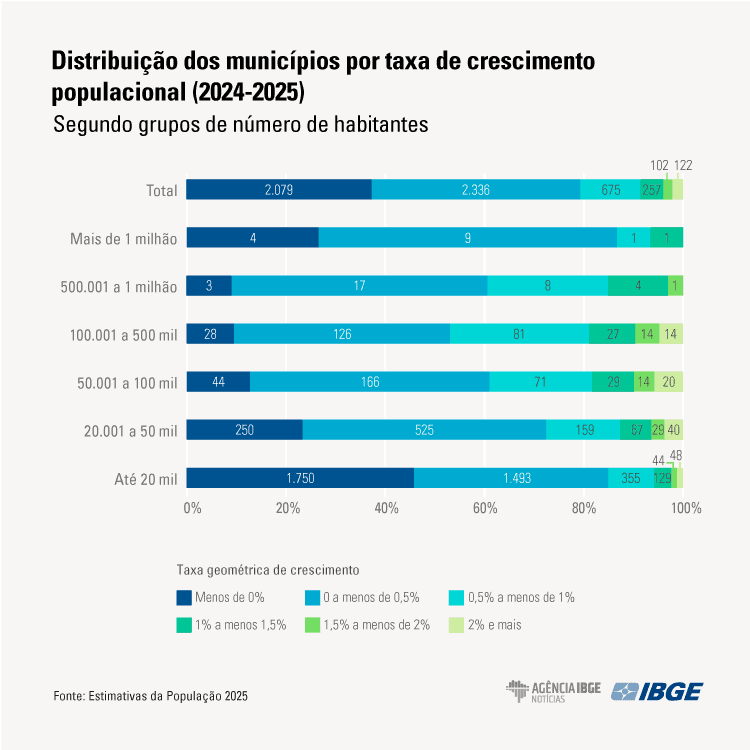Certainly! Here’s a rewritten and streamlined version of the content you provided, maintaining all key information in clear, concise language:
Brazil’s Population Estimated at 213.4 Million in 2025
According to the latest Population Estimates released by IBGE on April 28, 2025, Brazil’s population is projected to reach approximately 213.4 million people by July 1, 2025. This represents a growth rate of 0.39% compared to the previous year. The total number of municipalities in the country now stands at 5,571, including the newly created municipality of Boa Esperança do Norte (Mato Grosso), which has 5,877 inhabitants.
These population data are essential for calculating the States and Municipalities Participation Fund by the Federal Audit Court (TCU), as well as for socioeconomic and demographic indicators between demographic censuses. The estimates also account for territorial boundary changes since the 2022 Census.
Population Growth Trends
Marcio Minamiguchi, manager of Studies and Analyses of IBGE’s Demographic Dynamics, notes a continuing slowdown in population growth, consistent with findings from the 2022 Census and previous population projections.
Urban Concentration and Capital Cities
- The 27 state capitals collectively house 49.3 million people, nearly 23.1% of Brazil’s total population.
- Among capitals with over one million inhabitants, population growth was generally below 1%, except for Manaus (Amazonas), which grew by 1.05%.
- Capital cities that experienced population decreases compared to 2024 include Salvador (-0.18%), Belo Horizonte (-0.02%), Belém (-0.09%), Porto Alegre (-0.04%), and Natal (-0.14%).
- Boa Vista (Roraima) recorded the highest growth rate among capitals at 3.26%, largely due to international migration, especially from Venezuelan immigrants.
- Other notable increases occurred in Florianópolis (Santa Catarina) at 1.93%, Palmas (Tocantins) at 1.51%, and Cuiabá (Mato Grosso) at 1.31%.
Municipal Population Dynamics
- Out of 5,571 municipalities:
- 2,079 (37.3%) saw population declines.
- 3,011 (54%) had growth rates between 0% and 0.9%.
- Only 122 (2.2%) experienced growth of 2% or more.
- Nearly half (45.8%) of municipalities with populations up to 20,000 inhabitants experienced decreases, the highest proportion among all size groups.
- Municipalities with populations between 100,000 and 500,000 showed the highest proportion (19.0%) of growth above 1%.
- The Central-West region has the largest share (26.5%) of municipalities with growth rates over 1%, while the South and Northeast have the highest percentages of population decline, at 41.6% and 39.2% respectively.
Most and Least Populous Municipalities
-
The five least populous municipalities are:
- Serra da Saudade (MG) – 856 inhabitants
- Anhanguera (GO) – 913 inhabitants
- Borá (SP) – 932 inhabitants
- Araguainha (MT) – 997 inhabitants
- Nova Castilho (SP) – 1,072 inhabitants
-
Fifteen municipalities have populations exceeding one million, accounting for 42.8 million people or 20.1% of the national population. Among these, 13 are state capitals. São Paulo leads with nearly 11.9 million residents, followed by Rio de Janeiro (6.7 million) and Brasília (3 million).
-
Guarulhos and Campinas (both in São Paulo) are the only municipalities with over one million residents that are not state capitals, with 1.35 million and 1.19 million inhabitants respectively. They are the largest among the 26 municipalities with over 500,000 residents that are not capitals.
Population of Metropolitan Regions and Integrated Development Regions (RIDEs)
- The São Paulo metropolitan area remains the most populous with 21.6 million inhabitants, followed by the Rio de Janeiro metro area (12.9 million), Belo Horizonte metro area (6 million), and the Distrito Federal’s RIDE (4.8 million).
- Among metropolitan areas and RIDEs with over one million inhabitants, Florianópolis metropolitan region had the highest growth rate at 2.24%.
- Salvador metropolitan area was the only one to experience a slight population decline (-0.01%) compared to 2024.
Selected Tables
Population of State Capitals (2025) (Top 5)
| Rank | State | City | Population | Growth Rate (%) |
|---|---|---|---|---|
| 1 | SP | São Paulo | 11,904,961 | 0.08 |
| 2 | RJ | Rio de Janeiro | 6,730,729 | 0.01 |
| 3 | DF | Brasília | 2,996,899 | 0.47 |
| 4 | CE | Fortaleza | 2,578,483 | 0.16 |
| 5 | BA | Salvador | 2,564,204 | -0.18 |
Municipalities with Over One Million Inhabitants (2025)
| Rank | State | Municipality | Population |
|---|---|---|---|
| 1 | SP | São Paulo | 11,904,961 |
| 2 | RJ | Rio de Janeiro | 6,730,729 |
| 3 | DF | Brasília | 2,996,899 |
| … | … | … | … |
Municipalities with Over 500,000 Inhabitants (excluding capitals)
| Rank | State | Municipality | Population |
|---|---|---|---|
| 1 | SP | Guarulhos | 1,349,100 |
| 2 | SP | Campinas | 1,187,974 |
| 3 | RJ | São Gonçalo | 960,196 |
| … | … | … | … |
Source: IBGE – Directorate of Research, Population and Social Indicators Coordination (COPIS).
Editorial: Social Statistics | Pedro Renaux
If you want, I can also provide a version formatted for web publishing or a report style document. Let me know!

















